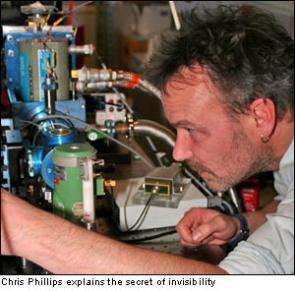Seeing is believing -- researchers explain 'x-ray specs' effect

An annual exhibition showcasing the best of UK science and technology this year includes a novel optical effect pioneered by physicists at Imperial College London.
The effect, which could one day render solid objects such as walls transparent, will be explained at the Royal Society Summer Science Exhibition between 3 and 6 July.
The technique has been developed by Chris Phillips and Mark Frogley at Imperial's Department of Physics with colleagues at the University of Neuchatel, Switzerland. The researchers believe it could eventually be used to see through rubble at earthquake sites or look at parts of the body obscured by bone, as well as having exciting potential for sending and storing secure data. Dr Frogley says:
"The whole team is looking forward to engaging with visitors to the exhibition and giving them a taste of the potential impact of this work on our lives. Science and physics in particular can seem daunting, so this is a great opportunity to show what life as a scientist is really like, and the excitement of achieving such amazing new effects."
The breakthrough is based on the development of a new material that exploits the way atoms in matter move, to make them interact with a laser beam in an entirely new way.
It is founded on a breakthrough which contradicts Einstein's theory that in order for a laser to work, the light-amplifying material it contains, usually a crystal or glass, must be brought to a state known as 'population inversion'. This refers to the condition of the atoms within the material, which must be excited with enough energy to make them emit rather than absorb light.
Quantum physicists, however, have long predicted that by interfering with the wave-patterns of atoms, light could be amplified without population inversion. This has previously been demonstrated in the atoms of gases but has not before been shown in solids.
In order to make this breakthrough, the team created specially patterned crystals only a few billionths of a metre in length that behaved like 'artificial atoms'. When light was shone into the crystals, it became entangled with the crystals at a molecular level rather than being absorbed, causing the material to become transparent.
This new transparent material created by the entanglement is made up of molecules that are half matter and half light. This allows light to be amplified without population inversion for the first time in a solid. Professor Phillips says:
"This real life 'x-ray specs' effect relies on a property of matter that is usually ignored - that the electrons it contains move in a wave-like way. What we have learnt is how to control these waves directly. The results can be pretty weird at times, but it's very exciting and so fundamental. At the moment the effect can only be produced in a lab under specific conditions but it has the potential to lead to all sorts of new applications."
Source: Imperial College London





















